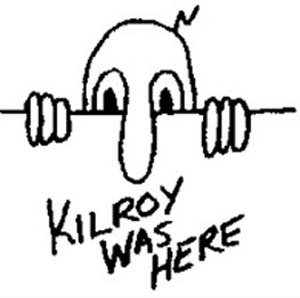
.

Nobody Beats Kilroy Anywhere!
by Colonel Bob Pappas, USMC, Retired
My first brush with “Kilroy” was in 1950 as a youngster in Athens, Greece (long before socialist idiots took over). At the Anglo-American School children of the recently won war, multi-national (oh, excuse me, multi-cultural although we didn’t know it then) expatriates attended classes; and, it was there that I first met “Kilroy.” Most were American children but also included were Brits, French, Indians, Turks, Egyptians, Italians, Spaniards and others from various embassies, military services and missionaries.
Kilroy was both legend and fad, the small drawing and inscription was ubiquitous and in the most unusual places. It was found on blackboards, the walls of restroom stalls, playground walls and basketball backboards. At that early age, it bugged me that “Kilroy” had been someplace ahead of me, but I soon got in the spirit although like my cohorts was too young to grasp its significance. It didn’t take long before I too would surreptitiously sketch Kilory on some vacant and obvious spot.
Decades later we had the privilege of riding the USS Iwo Jima on its maiden voyage from its birthplace at the shipyards Pascagoula, Ms. to Pensacola, Florida. There were about two thousand guests aboard that day and many sat on the flight deck to enjoy the sun and balmy breeze. As we strolled past one lady with leg in a cast, there, standing out from the hundreds of inscriptions was, you guessed it, “Kilroy Was Here.”
Most who read this remember well how very important “Kilroy Was Here” was to GIs in WWII, and Korea. It was less a symbol of the Viet-Nam era but survives today in Iraq and Afghanistan.
The best legend, and probably the closest to the truth of how it began is that James Kilroy, a rivet inspector on ships during WWII, to prove that he had inspected would scribble “Kilroy was here” throughout the ship.
Often ships were sent to sea before painting or cleaning up (one Liberty ship was actually built in four days; try that today!), so GIs and sailors found the graffiti in impossible places. Soon Kilroy became the super GI who always got there first, and survived. He began to appear in the most unlikely places such as enemy beaches, the Arc De Triomphe and much later is reported to have been scrawled in the dust on the moon. As Owen Edwards said in the Smithsonian; “‘Kilroy Was Here’ appeared almost everywhere American soldiers went.” There is one story of Stalin after emerging from a “porta-potti” (if one can believe they had such things during WWII) at the Malta Summit, asked, “Who is Kilroy?”
One may wonder why this crude drawing and scrawled words become the super GI of WWII, Korea, the Gulf War, Iraq and Afghanistan. We know how it probably started but why the “movement?” The Kilroy phenomenon was a manifestation of the absolutely amazing and indomitable sense of American humor. GI’s have always been able to find something funny to say and/or do to break the stress of combat or boredom in a world gone mad. No matter how bad it got, no matter what the danger, no matter how exhausted, scared or fed up they got, Kilroy was always there first, and survived.
Finally, “Kilroy Was Here” was an effort by millions of GI’s to be a little rebellious in a life almost totally controlled by others. “Kilroy Was Here” persisted in spite of repeated futile efforts stamp him out. A number of area commanders issued orders to eradicate Kilroy graffiti but consistent with the attitude that animated Kilroy, the orders were greeted with monumental if not deliberate indifference.
Like youngsters of every generation, GI’s of WWII were strikingly similar in their insistence on craving a piece individuality, and just like “pants on the ground” and the pierced/tattooed generation of today, millions seized Kilroy as a mascot if not a manifesto of their individuality and freedom of expression!
These were not warriors but ordinary “kids” caught up in forces far beyond their control. But they became warriors! By 1945 they were the most skilled combatants in the world although they never thought of themselves as such. Most were just guys who wanted to get the job done and go back to the farm, town or city they called “home.”
Kilroy still lives everywhere GIs passed, including courthouses, places of worship, markets, and other places limited only by ones imagination.
The generation that made Kilroy famous is now marching double time toward its eternal reward at the rate of more than a thousand members per day; it will not be too long before they are gone. They left behind freedom and a rich heritage that will live on in their legacy of sacrifice, bravery and wit. The torch has now been passed to a new generation of American servicemen and women who are equal to any challenge, adversity and enemy. If politicians would but listen to and permit them, they can and will keep this nation safe and free for another generation, until their time too has passed; that is, unless they get caught up in exercising “courageous restraint” and get themselves and us killed.
Static memorials grace Washington, State Capitols and towns across the country. The memorials honor those who served and too many whose lives were irreversibly altered or cut short in the interest of freedom, (even the freedom to give FREEDOM up for a “government handout”). Such memorials are well intended and fitting.
One long overlooked way of memorializing the “Greatest Generation” would be to issue a “Kilroy Was Here” postage stamp. The GIs of WWII and their successors have served in every clime, place and condition. In most instances postage stamps followed them and from those locales GIs have written millions of letters home. In a sense Kilroy is analogous to the ubiquity of military service and there could be no more unique or better way to honor or pay a lasting tribute to them and all who serve.
My good friend Pat Tillery, webmaster of Kilroywashere.org, has long championed the notion of a stamp that commemorates Kilroy that would honor all who served and who serve today! Join the effort!
Send your notes, cards, and/or letters to:
Citizens Stamp Advisory Committee
Stamp Development
US Postal Service
1735 North Lynn Street, Rm. 501
Arlington VA 22209-6432
The easiest way to help would be to go to:
http://www.kilroywashere.org/_00-temp/USPS-REQ.html
Where you can:
1. Print a pre-formatted letter to the Citizen’s Stamp Advisory Committee. You can sign and mail to the address provided.
2. Print a pre-formatted petition to be completed and mail to Citizen’s Stamp Advisory Committee
3. With one click, send a simple pre-formatted email to Kilroy Was Here. These will be printed and mailed every Monday.
And finally, motivate and enlist your friends and neighbors to give Kilroy a permanent place in Americana.
Semper Fidelis
.

Wild Thing’s comment……..
What a great article by the Col. Thank you Col. Pappas.
 ….Thank you Mark for sending this to me.
….Thank you Mark for sending this to me.
Mark
3rd Mar.Div. 1st Battalion 9th Marine Regiment
1/9 Marines aka The Walking Dead
VN 66-67

I have always liked what Kilroy stood for. I sent my email to USPS.
Tom, me too, thank you so much for all you do.